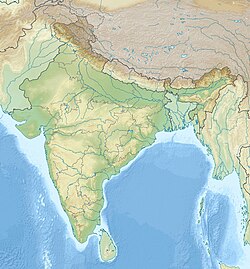Bharhut
| Bharhut | |
|---|---|
 East Gateway and Railings, Red Sand Stone, Bharhut Stupa, 2nd Century BCE. | |
| Religion | |
| Affiliation | Buddhism |
| District | Satna |
| Region | Vindhya Range |
| Ecclesiastical or organizational status | Stupa ruins present |
| Year consecrated | 200-300 B.C. |
| Status | Artifacts Removed |
| Location | |
| Location | India |
| State | Madhya Pradesh |
| Geographic coordinates | 24°26′N 80°52′E / 24.44°N 80.87°E |
| Pilgrimage to |
| Buddha's Holy Sites |
|---|
 |
Bharhut (Hindi: भरहुत) is a village located in the Satna district of Madhya Pradesh, central India. It is known for its famous relics from a Buddhist stupa. The Bharhut sculptures represent some of the earliest examples of Indian and Buddhist art.
Bharhut stupa
The Bharhut stupa may have been first built by the Maurya king Ashoka in the 3rd century BCE, but many works of art were apparently added during the Shunga period, with many friezes from the 2nd century BCE.[1] An epigraph on the gateway of the stupa mentions its erection "during the supremacy of the Shungas by Vatsiputra Dhanabhuti".[2]
In 1873, Alexander Cunningham visited Bharhut. The next year, he excavated the site.[3] J. D. Beglar, Cunningham's assistant, continued the excavation and recorded the work through numerous photographs.
The complex in Bharhut included a medieval temple (plate II), which contained a colossal figure of the Buddha, along with fragments of sculptures showing the Buddha with images of Brahma, Indra etc.[4] Beglar also photographed a 10th-century Buddhist Sanskrit inscription,[5] about which nothing is now known.
The ruined stupa—nothing but foundations of the main structure (see Gallery)—is still in Bharhut; however, the gateways and railings have been dismantled and reassembled at the Indian Museum, Kolkata.[2] They contain numerous birth stories of the Buddha's previous lives, or Jataka tales. Many of them are in the shape of large, round medallions. Two of the panels are at the Smithsonian.[6][failed verification]
As representative of early Indian art

In conformity with the early aniconic phase of Buddhist art, the Buddha is only represented through symbols, such as the Dharma wheel, the Bodhi tree, an empty seat, footprints, or the triratana symbol.[6]
The style represents the earliest phase of Indian art, and all characters are depicted wearing the Indian dhoti, except for one foreigner thought to be an Indo-Greek soldier, with Buddhist symbolism.[7] The Bharhut carvings are slightly earlier than the Sanchi carvings and the earlier Ajanta frescos.
An unusual feature of the Bharhut panels is the inclusion of text in the narrative panels, often identifying the individuals.[8]
Inscriptions
The inscriptions found at Bharhut are of considerable significance in tracing the history of early Indian Buddhism and Buddhist art. 136 inscriptions mention the donors. These include individuals from Vidisha, Purika (a town somewhere in the Vindhya mountains), Pataliputra (Bihar), Karhad (Maharashtra), Bhojakata (Vidarbha, eastern Maharashtra), Kosambi (Uttar Pradesh), and Nasik (Maharashtra). 82 inscriptions serve as labels for panels depicting the Jatakas, the life of the Buddha, former Manushi Buddhas, other stories and Yakshas and Yakshinis.[8]
Gallery
-
Excavation of the rail, East Gateway.
-
Bharhut excavation
-
Medieval Buddha image
-
The descent of Buddha
-
Anathapindika illustration
-
Vedika pillar with Greek warrior. Bharhut, Madhya Pradesh, Shunga Period, c.100-80BC. Reddish brown sandstone.[9] Indian Museum, Calcutta
-
Yakshi reliefs. Bharhut, 2nd century BCE.
-
The ruined Bharhut Stupa; seen behind it is the Lal Pahadi (Red Mountain)
-
Inscriptions
-
Inscriptions
-
Inscriptions
-
Inscriptions
-
East gateway and railings reassembled at the Indian Museum, Kolkata.
-
Railing section at Indian Museum
-
Railing section at Indian Museum
-
East gateway with railings at Indian Museum
See also
Notes
- ^ Marshall, John (1918). "An Historical and Artistic Description of Sanchi (pp. 7-29)". A Guide to Sanchi. Calcutta: Superintendent, Government Printing. p. 11. Retrieved 29 September 2014.
- ^ a b "Bharhut Gallery". INC-ICOM Galleries. Indian National Committee of the International Council of Museums. Retrieved 29 September 2014.
- ^ Cunningham, Sir Alexander (1879). The Stûpa of Bharhut: a Buddhist monument ornamented with numerous sculptures illustrative of Buddhist legend and history in the third century B.C. London: W. H. Allen.
- ^ "General view of remains of Buddhist temple of later date than the Stupa, Bharhut". Online Gallery. British Library. Retrieved 29 September 2014.
- ^ "Photograph of a slab with a Buddhist sanskrit inscription". Online Gallery. British Library. Retrieved 29 September 2014.
- ^ a b "The Art of Buddhism". The Freer Gallery of Art and Arthur M. Sackler Gallery. Smithsonian Institution. 2008. Retrieved 29 September 2014.
- ^ "The Diffusion of Classical Art in Antiquity, John Boardman, 1993, p.112
- ^ a b Luders, H.; Waldschmidt, E.; Mehendale, M. A., eds. (1963). "Bharhut Inscriptions". Corpus Inscriptionum Indicarum. Vol. II. Ootacamund: Archaeological Survey of India.
- ^ D.N. Jha,"Early India: A Concise History"p.150, plate 17
- ^ "The Diffusion of Classical Art in Antiquity, John Boardman, 1993, p.112








![Vedika pillar with Greek warrior. Bharhut, Madhya Pradesh, Shunga Period, c.100-80BC. Reddish brown sandstone.[9] Indian Museum, Calcutta](/upwiki/wikipedia/commons/thumb/f/fb/Greek_Warrior._Bharhut%2C_c._100_BC._Indian_Museum%2C_Calcutta_ei05-13.jpg/63px-Greek_Warrior._Bharhut%2C_c._100_BC._Indian_Museum%2C_Calcutta_ei05-13.jpg)










